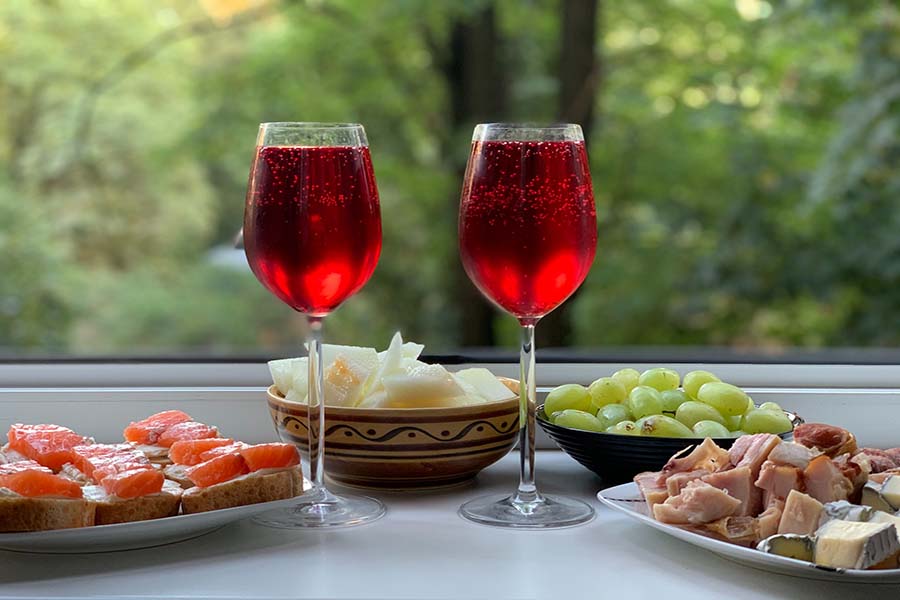Cheers to Flavors: Perfectly Pairing Wine & Beverages!

When enhancing your dining experience, pairing the right beverage with your meal can make all the difference. Wine, in particular, has long been associated with sophisticated dining, but the world of beverage pairing goes far beyond just wine.
In this blog, we will explore the art of pairing wine and other beverages with different types of cuisine, helping you elevate your culinary adventures to new heights.
Why Beverage Pairing Matters
Pairing the right beverage with your meal can significantly enhance the flavours and textures, creating a harmonious balance that elevates the food and drink. The right pairing can complement and accentuate the flavours of the dish, while the wrong pairing may result in a clash of flavours that can be unpleasant. Understanding the impact of beverages on the overall dining experience is essential.
Wine Pairing Basics
Consider the Intensity of the Dish
When pairing wine with food, it’s essential to consider the dish’s intensity. Light-bodied wines pair well with delicate and subtle dishes, while full-bodied wines can stand up to richer and more robust flavours. By matching the intensity of the wine with the intensity of the dish, you can create a balanced and enjoyable pairing.
For example, light-bodied white wines such as Sauvignon Blanc or Pinot Grigio work well with seafood, salads, and lighter poultry dishes. The crisp acidity and citrus notes of these wines can refresh the palate and enhance the delicate flavours of the food. On the other hand, medium-bodied red wines like Merlot or Sangiovese pair nicely with pasta dishes, grilled meats, and dishes with tomato-based sauces. The tannins in these wines can complement the dish’s richness and provide a pleasant mouthfeel. Full-bodied red wines such as Cabernet Sauvignon or Syrah are the perfect choice for heartier red meats, stews, and aged cheeses. These wines have bold flavours and robust tannins that match the dish’s intensity.
Consider the Flavor Profile
Another vital aspect to consider is the flavour profile of both the food and the wine. Certain flavours in the food can be enhanced or contrasted by the flavours in the wine, creating a harmonious pairing. Understanding the flavour profiles can create a more nuanced and enjoyable dining experience.
For example, spicy dishes can be balanced by off-dry or slightly sweet wines like Riesling or Gewürztraminer. The sweetness in the wine can help tame the heat and provide a refreshing contrast. Acidic dishes, such as those with citrus or tomato-based sauces, can complement wines with higher acidity, like Sauvignon Blanc or Chardonnay. The acidity in the wine can cut through the dish’s richness and provide a bright and refreshing sensation. Rich and creamy dishes, like risotto or buttery sauces, can be paired with wines that have a creamy texture or flavours, such as oaked Chardonnay or Champagne. The buttery notes in the wine can complement the dish’s richness and create a luxurious mouthfeel.
Other Beverage Pairing Options
While wine is often the go-to choice for beverage pairing, plenty of other options exist. Here are some alternatives you can explore:
Beer Pairing
Beer has a wide range of flavours and styles, making it a versatile choice for pairing with different types of cuisine. Each beer style has unique characteristics that can complement and enhance specific flavours in a dish.
Light lagers, with their crisp and clean profile, pair well with grilled foods, salads, and seafood. These beers’ light and refreshing nature can contrast the smoky flavours of grilled dishes and the lightness of salads and seafood.
With their hop-forward and bitter flavours, IPAs (India Pale Ales) go well with spicy dishes, burgers, and curries. The hop bitterness can help cut through the heat of spicy foods and provide a refreshing sensation.
With their light and refreshing qualities, wheat beers complement lighter dishes such as salads, seafood, and sushi. The subtle fruity and spicy notes in wheat beers can enhance the flavours of these dishes.
Stouts and porters, known for their rich and roasted flavours, pair nicely with rich, roasted, or chocolatey dishes, such as barbecue or chocolate desserts. The dark and complex flavours of these beers can complement the depth and richness of these dishes.
Spirits and Cocktails
Spirits and cocktails can also be excellent choices for beverage pairing, as they offer a wide range of flavours and profiles that can complement various cuisines. Here are some options to consider:
Whiskey, with its smoky and rich flavours, pairs well with grilled meats, rich and smoky dishes, or dark chocolate desserts. The complexity and depth of whiskey can enhance the flavours of these dishes.
With its herbal and citrusy notes, Gin goes well with seafood, salads, or light and herbal-flavoured dishes. The botanicals in Gin can provide these dishes with a refreshing and aromatic complement.
Vodka, known for its clean and neutral profile, complements creamy or citrusy dishes and spicy foods. The neutrality of vodka allows it to enhance the flavours of the dish without overpowering them.
Rum, with its tropical and fruity flavours, enhances tropical flavours in Caribbean or Latin American cuisine. The sweetness and complexity of rum can add depth to these dishes.
Cocktails, depending on the ingredients, can be paired with various dishes. From fruity and refreshing options for salads or seafood to bold and complex cocktails for richer and spicier dishes, there is a cocktail for every cuisine and flavour profile.
Non-Alcoholic Beverages
For those who prefer non-alcoholic options, there are plenty of beverage pairing choices. These alternatives can provide a refreshing and flavorful accompaniment to various dishes.
Sparkling water or soda are refreshing and versatile options that complement many dishes. Their enthusiasm and clean flavours can cleanse the palate and enhance the flavours of the food.
Iced or herbal tea pairs well with lighter dishes, salads, or Asian cuisine. The subtle flavours and herbal notes in these teas can provide a soothing and refreshing contrast to the food.
Fruit juices or smoothies can be paired with desserts, fruity dishes, or spicy meals to balance the flavours. These beverages’ natural sweetness and vibrant flavours can enhance the overall dining experience.
Final Tips for Beverage Pairing
Experiment and try different combinations to find your personal preferences. The world of beverage pairing is vast, with no hard and fast rules. Trust your palate and explore different options to discover unique flavour combinations.
Please seek advice from experts or sommeliers at restaurants for their recommendations. These professionals have extensive knowledge and experience in beverage pairing and can provide valuable insights and suggestions.
Consider the overall dining experience and your guests’ preferences when selecting the beverages. Factors such as the occasion, atmosphere, and personal preferences should all be considered to create a memorable dining experience.
Remember that beverage pairing is subjective; what works for one person may not work for another. Trust your taste buds and preferences. The goal is to create a harmonious and enjoyable dining experience for yourself and your guests.
Conclusion
Pairing the right beverage with your meal can significantly enhance your dining experience. Whether you choose wine, beer, spirits, or non-alcoholic options, understanding the basic principles of beverage pairing can help create memorable and harmonious flavour combinations. So, the next time you sit down to enjoy a delicious meal, remember to consider the perfect beverage to accompany it. Cheers!
If you found this post engaging, don’t forget to explore our additional blogs:
- Jet-Setter Must-Haves: Fashionable Travel Essentials!
- Unlock Wealth Secrets: Rich Dad Poor Dad Reveals All!
- Unleash Your Earning Potential: Mastering the Gig Economy Game!
- Unlock Your Peak Performance: Fast This Way with Dave Asprey!
- Revolutionise Your Kitchen: Master Zero-Waste Cooking Magic!
- Wild Adventures and Hilarious Mishaps: Bill Bryson’s Appalachian Trail Tale!
- Mastering AutoML: Perks, Uses & Hurdles Uncovered
- Love Unveiled: Cracking the Code of Relationships with John Gray!
- Unlocking Forever: Master the Secrets to Relationship Bliss!
- Unwrap the Magic: 2023’s Hottest Holiday Décor Trends Revealed!
Sign up for updates on this blog and our latest posts if you enjoyed reading this one.
Help your friends and colleagues stay informed about the newest insights on business, marketing, finance, lifestyle, and society by sharing our blog content through Facebook, Twitter, Pinterest, LinkedIn, email, or WhatsApp links below. We can create a knowledge-sharing community and empower one another to accomplish and experience our objectives.
FAQ
Why does beverage pairing matter?
Pairing the right beverage with your meal can significantly enhance the flavours and textures, creating a harmonious balance that elevates the food and drink.
How do I pair wine with food?
When pairing wine with food, consider the dish’s intensity and match it with the intensity of the wine. Light-bodied wines go well with delicate dishes, medium-bodied red wines pair nicely with pasta and grilled meats, and full-bodied red wines are suitable for heartier dishes.
How can I consider the flavour profile when pairing wine and food?
Certain flavours in the food can be enhanced or contrasted by the flavours in the wine. For example, spicy dishes can be balanced by off-dry or slightly sweet wines; acidic dishes can be complemented by higher acidity and rich and creamy dishes can be paired with creamy textures or flavours.
What are some alternatives to wine for beverage pairing?
Beer, spirits, cocktails, and non-alcoholic beverages are all options for beverage pairing. Each has unique characteristics that can complement and enhance specific flavours in a dish.
Credits
Featured photo by Iryna Mykhaylova on Unsplash.









